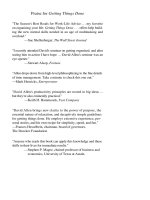The Art of Talking to Anyone: Essential People Skills for Success in Any Situation
Bạn đang xem bản rút gọn của tài liệu. Xem và tải ngay bản đầy đủ của tài liệu tại đây (2.12 MB, 257 trang )
OtherbooksbyRosalieMaggio
HowtoSayIt
HowtoSayItStyleGuide
TheNewBeaconBookofQuotationsbyWomen
TalkingAboutPeople
MarieMarvingt:Femmed’unSiècle
TheMusicBoxChristmas
HowTheySaidIt
GreatLettersforEveryOccasion
MoneyTalks
AnImpulsetoSoar
QuotationsonLove
QuotationsfortheSoul
QuotationsonEducation
QuotationsFromWomenonLife
TheDictionaryofBias-FreeLanguage
TheNonsexistWordFinder
TheTravelsofSoc
Copyright©2005byRosalieMaggio.Allrightsreserved.Exceptaspermitted
undertheUnitedStatesCopyrightActof1976,nopartofthispublicationmay
bereproducedordistributedinanyformorbyanymeans,orstoredina
databaseorretrievalsystem,withoutthepriorwrittenpermissionofthe
publisher.
ISBN:978-0-07-150600-7
MHID:0-07-150600-4
ThematerialinthiseBookalsoappearsintheprintversionofthistitle:ISBN:
978-0-07-145229-8,MHID:0-07-145229-X.
Alltrademarksaretrademarksoftheirrespectiveowners.Ratherthanputa
trademarksymbolaftereveryoccurrenceofatrademarkedname,weuse
namesinaneditorialfashiononly,andtothebenefitofthetrademarkowner,
withnointentionofinfringementofthetrademark.Wheresuchdesignations
appearinthisbook,theyhavebeenprintedwithinitialcaps.
McGraw-HilleBooksareavailableatspecialquantitydiscountstouseas
premiumsandsalespromotions,orforuseincorporatetrainingprograms.To
contactarepresentativepleasee-mailusat
Thispublicationisdesignedtoprovideaccurateandauthoritativeinformation
inregardtothesubjectmattercovered.Itissoldwiththeunderstandingthat
neithertheauthornorthepublisherisengagedinrenderinglegal,accounting,
orotherprofessionalservice.Iflegaladviceorotherexpertassistanceis
required,theservicesofacompetentprofessionalpersonshouldbesought.
—FromaDeclarationofPrinciplesjointlyadoptedbyCommitteeofthe
AmericanBarAssociationandaCommitteeofPublishers.
TERMSOFUSE
ThisisacopyrightedworkandTheMcGraw-HillCompanies,Inc.(“McGrawHill”)anditslicensorsreserveallrightsinandtothework.Useofthisworkis
subjecttotheseterms.ExceptaspermittedundertheCopyrightActof1976and
therighttostoreandretrieveonecopyofthework,youmaynotdecompile,
disassemble,reverseengineer,reproduce,modify,createderivativeworks
basedupon,transmit,distribute,disseminate,sell,publishorsublicensethe
workoranypartofitwithoutMcGraw-Hill’spriorconsent.Youmayusethe
workforyourownnoncommercialandpersonaluse;anyotheruseofthe
workisstrictlyprohibited.Yourrighttousetheworkmaybeterminatedifyou
failtocomplywiththeseterms.
THEWORKISPROVIDED“ASIS.”McGRAW-HILLANDITSLICENSORS
MAKENOGUARANTEESORWARRANTIESASTOTHEACCURACY,
ADEQUACYORCOMPLETENESSOFORRESULTSTOBEOBTAINED
FROMUSINGTHEWORK,INCLUDINGANYINFORMATIONTHATCAN
BEACCESSEDTHROUGHTHEWORKVIAHYPERLINKOR
OTHERWISE,ANDEXPRESSLYDISCLAIMANYWARRANTY,EXPRESS
ORIMPLIED,INCLUDINGBUTNOTLIMITEDTOIMPLIED
WARRANTIESOFMERCHANTABILITYORFITNESSFORA
PARTICULARPURPOSE.McGraw-Hillanditslicensorsdonotwarrantor
guaranteethatthefunctionscontainedintheworkwillmeetyourrequirements
orthatitsoperationwillbeuninterruptedorerrorfree.NeitherMcGraw-Hill
noritslicensorsshallbeliabletoyouoranyoneelseforanyinaccuracy,error
oromission,regardlessofcause,intheworkorforanydamagesresulting
therefrom.McGraw-Hillhasnoresponsibilityforthecontentofany
informationaccessedthroughthework.Undernocircumstancesshall
McGraw-Hilland/oritslicensorsbeliableforanyindirect,incidental,special,
punitive,consequentialorsimilardamagesthatresultfromtheuseofor
inabilitytousethework,evenifanyofthemhasbeenadvisedofthe
possibilityofsuchdamages.Thislimitationofliabilityshallapplytoany
claimorcausewhatsoeverwhethersuchclaimorcausearisesincontract,tort
orotherwise.
ToDAVIDLiz,Katie,Matt,Nora
Contents
Introduction
PartOne:TheBasics
Chapter1:HowtoSucceedinAnyConversation:FromStarttoFinish
Chapter2:HowtoBeUniversallyLiked
Chapter3:HowtoListenSuccessfully
Chapter4:HowtoKeepaConversationGoing—orStopOne
Chapter5:HowtoAskandAnswerQuestions
Chapter6:HowandWhentoTellJokes
Chapter7:HowtoDealWithConversationalPredicaments
Chapter8:HowtoBeanUnpopularConversationalist
PartTwo:TheSpecifics
Chapter9:TalkingWithAnyoneintheWorkplace
Chapter10:TalkingWithAnyoneatMeetingsandConferences
Chapter11:TalkingWithAnyoneatBusiness-SocialEvents
Chapter12:TalkingWithAnyoneatSocialEvents
Chapter13:TalkingWithAnyoneinPublicPlaces
Chapter14:TalkingWithAnyoneontheTelephone
Chapter15:TalkingWithAnyoneinTimesofTrouble
Chapter16:TalkingWithFamilyandFriends
Chapter17:TalkingWithRomanceinMind
Index
Introduction
Thereisnoreasonwhyanyoneofuscannot
becomeagoodconversationalist.…Itis
universalanditisoneofthemostdecisive
factorsinoursuccessorfailure.
—LILLIAN EICHLER
Ifyouhavepickedupthisbook,youmostlikelybelievethatbeingableto
conversefluentlyandappropriatelyisakeyfactorinyourworkplacesuccess
andyourpersonalhappiness.Youdon’tneedtobeconvincedofitsimportance.
TheArtofTalkingtoAnyonerestsonthissharedunderstandingandoffersyou
notthewhyofconversation,butthehow.
Theassumptionhereisthatyoucanalreadyconverse—you’vebeendoing
itmostofyourlife—andthatyouareamuchbetterconversationalistthanyou
realize.Butyouare,ifnotaperfectionist,atleastastriver,andyouwanttobe
better.
TheArtofTalkingtoAnyonewillprimeyourpump,jump-startyour
battery,providetheinspirationyouneedtoattainabsoluteconfidenceinyour
abilitytosaytherightthingtoanyone,anytime,anywhere.
PartOneisyourtoolbox.Guidelinesandstrategiesprovideyouwith
everythingyouneedtobecomeamoresuccessfulconversationalist:Whatisa
goodquestion?Whenshouldyounottellajoke?Howdoyougetawayfroma
nonstoptalker?Whatverbalticsmightyouunknowinglyhave?Howdoyou
respondtoarudequestion?How,exactly,doyouintroducetwopeopletoeach
other?
PartTwoofferspracticalhelpmakingconversationinnineareasofyour
life.Eachchapterincludessuggestionsonwhattosay,whatnottosay,whatto
doinspecialcircumstances,andhowyoumighthandlevarioussituations.The
section“IfTheySay…YouSay…”illustratestheback-and-forthnatureof
talkingwithothers.
Noonesaysbeingawell-likedandcharmingconversationalistiseasy.
Morethanahundredyearsago,GamalielBradfordconfessed,“SomehowI
findtalkveryunsatisfactory.IneversaythethingsImeanttosayandam
overwhelmedafterwardswiththethingsIshouldhavesaidandcouldnot.”
Soundfamiliar?
Someoneonceaskedafriend,“Howdidyougettobereallygoodat
makingconversation?”Thefriendreplied,“Byexperience.”“Oh?”askedthe
other.“Andhowdidyougetyourexperience?”Thefriendsaiddryly,“From
beingreallybadatmakingconversation.”
TheArtofTalkingtoAnyonewillsaveyoufromhavingtomakebad
conversationonyourwaytobecomingaself-assured,sought-after,successful
conversationalist.
TheArtofTalkingtoAnyone
PartOne
TheBasics
CHAPTER1
HowtoSucceedinAnyConversation:FromStartto
Finish
Goodmanners—thelongerIlivethemoreconvincedI
amofit—areapricelessinsuranceagainstfailureand
loneliness.Andanyonecanhavethem.
—ELSAMAXWELL
BeforeTalkingWithAnyone
Theartofconversingwithanyonebeginslongbeforeyouarriveatwherever
youhopetospeakcharminglyandintelligently.Thischaptertellsyouwhatyou
needtoknowforeverystepofaconversation,fromintroductionstobody
languagetoendingtheconversationgracefully.
ConvinceYourselfYouWanttoGo
Thefirststepistochoosetobethere.Ifit’stheworkplace,youareallowedto
feelambiguousaboutyourdecisionsomemornings,buttomakeagood
impression—atwork,atameeting,ataparty,oratanykindofgathering—go
withapositiveattitude.
Positivepeoplecantakeonthe
world.
—RICKPITINO
Ifyouhatebeingsomeplace,youcanimaginethatyourconversationwill
notbescintillating.Soeithertakeyourhappyfacewithyouorstayhome.If
youareattendingsomethingunwillinglybecauseofworkorfamily
obligations,rememberthatagoodattitudeandabadattitudearesimply
differentwaysoflookingatthesamesituation.Yourchoice.
HaveSomethingtoSay
Don’tleavehomewithoutit:somethingtosay.Chancesareyoureadadaily
newspaper,perhapsaweeklynewsmagazine,and,ifyoubelongtothat
particular53%oftheU.S.population,abooknowandthen.Collectfodderfor
conversationfromtheradio,friends,sermons,lectures,publictelevision,
eavesdroppingonthesubway,orwaitinginlineatthegrocerystore.Keeping
upwithcurrenteventsandpopularcultureensuresyou’llneverbecaughtshort
intheconversationsweepstakes.
Youwon’t,ofcourse,baldlydropwhateveryouknowintothe
conversation.Whenyoufeeltheneedtobreakasilence,startwithaquestion:
“Didyouseethearticleinthismorning’spaperabout.…?”“Hasanyoneread
StephenKing’slatest?”Ifthereisnointerestinyourgambit,trysomething
elseorhopeanotherpersoninthegrouphasbeendoingtheirhomework.
Youmightkeepalistofconversationtopics—activitiesthatinterestyou,
questions,ideas—andreviewthembeforeleavingforasocialorbusiness
event.Youmightnotneedthem,butyou’llfeelbetterknowingyoucanhold
yourownifyouhaveto.
Ifyoucan,findoutalittleaboutthosewhowillbeattendingtheevent.That
informationplusthreeorfourconversationaltidbitsshouldseeyouthrough
almostanysituation.Butdon’teventhinkaboutrehearsingpossible
“conversations.”Theirregularnatureofmostconversationsmakesthem
unpredictable,andyou’lllookstiltedbesides.
TakeYourBestSelfWithYou
Thesinglemostimportantelementinbeingthekindofpersoneveryonewants
totalkwithis…confidence.Youwanttowalkintoaroom,comfortableinthe
knowledgethatyouarehappytobethere,thatyou’relookingforwardto
meetingsomeinterestingpeople,andthatyoucanhandlewhatever
conversationalchallengescomeyourway.
Expecttobelikedandaccepted.Takeforgrantedthatpeoplewillbehappy
toseeyou.Andwhat’snottolike?Youwereinvited,you’repartofthisgroup,
you’reagoodperson.
Thethreeprinciplesbehindlooking,acting,andbeingconfidentare:
1.Peoplewilltakeyouatyourownevaluation.Yourattitudesabout
yourselfbouncebacktoyoufromotherpeople.Ifyouthinkyouhave
nosocialskills,otherpeoplewilleventuallycometoagreewithyou.If
youthinkyouhavenothingtosay,youcertainlywillhavenothingto
say,andpeoplewillstartseeingyouassomeonewhohasnothingto
say.Ifyouthinkyouareanobody,youarepracticallyaskingpeopleto
treatyouthatway.Ontheotherhand,ifyouthinkofyourselfasakind,
intelligent,charmingperson,that’sthewayyou’llbeperceived.
People,informingtheiropinionsof
others,areusuallylazyenoughtogo
bywhateverismostobviousor
whateverchanceremarktheyhappen
tohear.Sothebestpolicyisto
dictatetootherstheopinionyou
wantthemtohaveofyou.
—JUDITHMARTIN
2.Peoplewillcatchandmirroryouremotionalstates.Ifyouare
enthusiastic,theywillbetoo;ifyouarebored,theywillalsobebored.
3.Peopletendtobehavethewayyouthinktheywillbehave.Ifyouthink
peoplearecoldandsnooty,theywillprobablyendupactingthatwayto
you.Ifyouthinktheylookdownonyou,ultimatelytheyprobablywill.
Butifyouthinkpeopleareinteresting,warm,andfunny,theywillnot
makealiarofyou.Ifyouexpectpeopletoacceptyou,theywill.
Peoplewillknowifyourattitudeisdefensiveandinsecure,orifitis
relaxedandopen.Theymightnotthinkitthrough,butatsomelevel,whatever
youthink,feel,andprojectwillbepickedupbyothersandreturnedtoyou.
Allpowerisbasedonperception.If
youthinkyou’vegotit,thenyou’ve
gotit.Ifyouthinkyoudon’thaveit,
evenifyouhaveit,thenyoudon’t
haveit.
—HERBCOHEN
Becausetheaimofsmalltalkistomakepeoplecomfortableandtoput
themattheirease,aself-conscious,tense,nervousconversationalistisgoing
tobesociallyinadequate.
Youhavedoubts.Bysomemagic,youareexpectedtogofromasocial
shipwrecktoaconversationalQueenMary?
Themagicisto“actasif.”Actasifyouarebraveandconfident.Actasif
othersarehappytoseeyou.You’vegottobelieve—oratleastactasthough
youbelieve—thattheotherpersonisgoingtoenjoyspendingafewminutes
withyou.
Itmightfeelartificialatfirst,butthemoreyou“actasif,”themorethenew
behaviorswillbegintofeelcomfortable.Keepremindingyourselfthatthevast
majorityofanygroupiskind,wellmannered,andwillingtogiveanyonea
chance.Evenasecondchance.
Feelfreetobethinking,“Help!I’mafishoutofwater!I’mgoingtodie.I
don’tknowwhattosay!I’mboring!Nobodyisinterestedinme!I’mgoingto
spillsomething!They’regoingtodiscoverI’mafraud!”Thinkanythingyou
like—butstandupstraight,smile,shakehands,andcalmlyandcharminglysay,
“It’sapleasuretomeetyou.”
Rememberthis:Youarenoteveryone’scupoftea.It’ssimplynotpossible
thateveryindividualatagatheringwillwanttomarryyou,beyourbestfriend,
orshareanofficewithyou.Whatwouldyoudowiththatmanypeopleinyour
lifeanyway?Somostpeopleyouspeakwithwillprovidelow-key,pleasant
conversation,butyoudon’tneedtobea“hit”witheveryone.Youdonotneed
tobeperfect.Thedesireforperfection,fordoingthingsabsolutely“right,”
hasbeenthedownfallofmanyagoodconversationalist.Relax.Intheend,this
orthatsmallconversationdoesn’tmatterinthelargeschemeofthings.
Nothingismoreessentialtosuccess
inanyareaofyourlifethanthe
abilitytocommunicatewell.
—PAULW.SWETS
You’llbemorepopular,andthusprobablyhappier,ifyouconcentrateon
makingtheotherpersonfeelgood.Youcan’tmakeanyonelikeyou,butit’sin
yourpowertoshowlikingforothers.
CheckOutYourBodyLanguage
Fromthemomentyouwalkinthedoor,yourbodyisbusytellingpeopleall
aboutyou.
Whatwouldyouthinkaboutsomeonewhorushedintoagathering,looking
harriedandslightlysweaty?Orsomeonewhoslouchedinfurtively,hopingnot
tobenoticed?Orsomeonewhohad“apologetic”writtenalloverthem,from
hunchedshoulderstopuppy-dogeyes?Youprobablywouldn’tbeanxiousto
talkwiththatperson.Thinkabouttheimageyouwanttoproject.Shouldn’titbe
oneofconfidence?
Posture
Withanyluck,youalreadyhavegoodposture.It’sdistractingtobetryingto
conversewithpeoplewhilesimultaneouslyhissingtoyourself,“Standup
straight!”“Shouldersback!”“Stomachin!”Ifyourpostureneedswork,work
onitbeforeandafter,notduring,eventsthatcallforconversation.Selfconsciousnesswillpreventyoufrombeingtheinterestingpersonyoucanbe.
Movementneverlies.
—MARTHAGRAHAM
Thepersonwhostandstall—butnotstiffly—andmovesinacalm,
purposefulwayautomaticallycommandsrespect.Fromthemomentyouenter
aroomwithdignityandeasyconfidence,youtellpeopleyouaresomeone
whomatters—toyourselfandtothem.
Goodpostureincludesthewayyouholdyourhead.Studythewaypeople
inyourlifecarrytheirheadsandseewhatyouthinkofthedifferences.
Ingeneral,keepyourheadlevel(themetaphor“levelhead”didnotspring
fromnowhere).Alevelheadindicatesanassured,candid,capablenature.It
mightalsogiveyourvoicefullertonesandmakeyouseemtobelooking
peoplestraightintheeye.
Abowedhead,eyesstudyingthefloor,makesyoulookunsure,vulnerable,
passive,andpossiblyevenguiltyofsomething.
Tiltingyourheadtoonesideortheother(mostpeopletilttotheright),
mayshowcuriosityandinterest.Butitmayalsoindicateunease,helplessness,
dependence,orbewilderment.
FidgetingandGestures
Somebodylanguageisdifficulttocontrol:
Blushing
Contractionoffacialmuscles
Involuntarygrimaces
Rapidblinking
Workingonyourself-confidenceandyourcomfortlevelistheonlycure
forthesetypesofreflexes.Theywilldisappearwhenyoubegintoseeyourself
asanableandresourcefulconversationalist.
Otherbodylanguagecanbecontrolledwithpractice:
Adjustingyoureyeglasses
Clearingyourthroatconstantly
Crossingyourarmstightlyoveryourchest
Fiddlingwithapen,purse,orotherobject
Fidgeting
Fingeringringsorjewelry
Foldingandunfoldingyourarms
Giggling
Glancingcontinuallyatyourwatch
Hitchingupyourbelt
Laughingnervouslyortooloudly
Lookingaroundtheroom
Makingdistractinggestures
Pickinglintfromyourclothes
Playingwithyourtie
Pocketingyourhands
Pushingback,flipping,smoothing,orfluffingyourhair
Rockingonyourfeet,side-to-side,orforwardsandbackwards
Scratchingyourheadorchin
Slouchingorleaning
Smoothingyourclothing
Tuckinginbraorslipstraps
Tuggingatshirtcuffs
Twistingamustache
IneverlookatmywatchifI’m
talkingwithsomeone.Ithinkthat’s
suchaninsultinggesture!Itsuggests
you’retryingtogaugewhetheryou
thinkwhatthey’resayingisworth
yourtime.
—FRANCESHESSELBEIN
Thefirststepistobeawareofwhatyou’redoing;mostofthesebehaviors
belongtopeoplewhohavenoideathey’refidgeting.Repetitiveandpointless
gesturesspringfromnervousnessandinsecurity.Onceyoubegingaining
confidenceinyourskillsandpopularityasaconversationalist,itwillbefairly
easytoweedthemout.
Anunnervingtraitinaconversationalpartnerisdistractibility.Don’tlet
yourattentionwanderfromtheotherpersontotheloudlydressedindividual
acrosstheroomortheinexplicablechoiceofartonthewallsortheentrance
ofnewcomersortheconversationgoingonnexttoyou.Ignoreeverythingbut
thepeoplewithwhomyou’reconversing.
Otherbodylanguagetobeavoidedincludes:
Shaking,wavingfromsidetoside,orpointingyourforefingeratanother
person(thisisanincrediblyaggressiveandunwelcomegesture—there
areotherwaystopunctuateyourremarks).
Standingtoocloselytosomeone.Thepreferenceforpersonalspace
varies,butitisimportanttosomepeople.Thebestwaytohandlethisis
tokeepyourdistance;lettheotherpersonmovetowardyou.Thisis
psychologicallyagoodstrategy,bothinshowingrespecttotheother
personandintheotherpersondemonstratingtheir“attraction”toyouby
movingcloser.
Inmoderation,gesturesareappreciatedaslongastheyarenotalwaysthe
samegesture.Aftercheckingthelistaboveforthefidgetingkindsofgestures,
useanyothersthatfeelnaturaltoyou.
Ifyoutraveltoothercountries,familiarizeyourselfwiththesocialand
businesscustomsthere.Forexample,intheUnitedStatesthe“okay”sign(the
Owithforefingerandthumb)meansmoneyinJapan,andinItalyandLatin
Americacanbeinsulting.Pattingachildontheheadisconsideredabenign,
evencharminggestureinmanycountries;inIslamiccountriesitmustbe
strictlyavoidedbecausetheheadistheholiestpartofthebodyandnottobe
touched.Anumberofbooks,includingseveralgoodseries,detailcultural
issuesforvisitorstoothercountries.
“Beyourself”isgoodadvice,unless
younoticethatpeoplearealways
excusingthemselvesandmoving
awayfromyou.Inthatcase,try
beingsomeoneelse!
—SUSAN ROANE
Smile!
Allthatsaid,youmightbewonderingwhatphysicalmovementsarelefttoyou.
Thebestonesareagoodsmileandanoccasional,meaningfulnod.Senseless
andtoo-frequentnoddingistheoppositeoftheinfrequent,thoughtfulnod,
whichtellspeopleyouareinvolvedinwhatthey’resaying.
Butthesmile—oh,thesmilewillworkmiracles.Itisthemostimportant
bodylanguageofall,signalingthatyouareaffable,comfortableinyourskin,
andreceptivetowhoevertheotherpersonmightbe.Thetendencyofthe
humanbeingistoreflecttheemotiontheotherpersondisplays.Ifyousmile,
chancesareverygoodtheotherpersonwillsmileback.
Toppeoplesmilemorefrequently
thanpeopleonanyotherrungofthe
careerladder—andnotjustbecause
theymakemoremoney.
—D.A.BENTON
Insomepeople,thesmileisalmostaninvoluntarytic.Theysmile
regardlessofthecontentofwhatthey’resaying.However,ifthisisyou,before
youstarttryingtofixit,rememberthattherearelotsworsethingswecansee
onpeople’sfacesthanasmile.
Theremustbesomesmilesthatarenotdesirable—theinsinceresmile,the
strainedsmile—butanyonetryingtosmileforwhateverreasonshouldbe
givenachancetocomeupwitharealsmile.Anysmileisprobablyagood
smile.
Introductions
Althoughtherearerulesforintroducingonepersontoanother,don’tworryif
theysuddenlyflyoutofyourhead.Insteadofbeingseizedwithhorrorand
tryingtorememberwhatyou“ought”todo,simplytrustyourself,treatboth
peoplewithlikingandrespect,andfigureoutawayforeachofthemtoknow
theother ’sname.Itisn’tmuchmorecomplicatedthanthat.
Tointroducetwopeople:(1)givetheirfullnamesand(2)addan
impersonalidentifyingtagsuchas:
“Adearfriendofmine”
“Mybusinesspartner”
“Myneighborinthenextcondo”
“MynieceSusan”
“Thenewarchitectwithourcompany”
Byaddingatagline,yougivethetwopeopleaplacetobegina
conversation(“Howlonghaveyoulivedinthisbuilding?”“Doyoulivein
town,orareyouvisiting?”).Donotattachembarrassingorexcessivetags(“I
usedtochangehisdiaperswhenhewaslittle”;“She’sthebestpumpkin-pie
makerinthecountrytoday”).Ifyouknowthatthetwopeoplehavesomething
incommon(theybothrecentlytraveledtoPeru;theybothcollect
paperweights;theybothknowyourbrother),mentionit.
Thepartofintroductionsthatgenerallyisachallengeisdeciding
(quickly)whogetsintroducedtowhom.Theformulais:
“Mother,I’dlikeyoutomeetLittleJackHorner.”
“Jack,thisismymother,ImaGoose.”
Althoughwethinkwe’reanegalitariansociety,onepersonisusually
rankedalittlemorehighlythantheother.Thatpersongetstofindoutfirstwho
theotherpersonis.Thehigher-rankedpersonisontheleft:
Forthefirstperson,usethenameyouareaccustomedtousing.Ifyou
introduceyourbosstosomeone,dependingonyourplaceintheorganization,
youmightsay,“Ms.George,I’dlikeyoutomeetmywife,JuneOlson.”Each
introductionisalittledifferentfromeveryotherone.However,thesamples
belowdemonstrateinageneralwayhoweffectiveintroductionswork:
Courtesyisthebedrockofsocial
interchange.
—JOAN M.DRURY
“Anna,doyouknowBobLorimer?Ah,good,thenIgettointroduce
you.BobisatranslatorwithPelhamOil.Bob,thisisAnnaPierson,
alsoatranslator,butwithGuest&Company.”
“Dad,I’dlikeyoutomeetafriendofmine,JoniKessell.Joni,thisismy
father,ArnoldDombey.Yes,thegeologyprofessorhimself!Dad,
Joniismajoringingeologyandshe’salwayswantedtomeetyou.”
“Eden,you’veheardmetalkaboutFarleyNovak.Farley,thisismy
goodfriendandcolleagueEdenMurchison.Ibelieveyoubothwent
toYale,butatdifferenttimes.”
“Inormallyhesitatetointroducetwoofmyfriendstoeachother
becausetoooftenitdoesn’tseemtoworkout,butIthinkthisisa
specialcase.Chris,I’dlikeyoutomeetDanaCasserly.Dana,thisis
ChrisDeadham,andthereasonIthoughtyou’denjoymeetingisthat
youaretheonlytwopeopleIknowwhobothspeakFarsi!”
“Irene,haveyoumetFrankCooper?He’smyassistant,withoutwhomI
couldn’texist.Frank,thisisIreneMaundrell,ourManhattanRegional
Director.”
“Maria,I’dliketointroduceyoutoEthelOrmiston,whoisourvery
favoriterealtor.Ethel,thisisMariaGauss.Sheandherhusband
Eugenearegoingtoputtheirhomeonthemarketsoon.”
“Millicent,thisisHannahVorbrüggen,anexchangestudentfrom
Germany.Hannah,I’dlikeyoutomeetmysister-in-law,Millicent
Cassine.TheirchildrenaretakingGermanandMillicentwas
wonderingifyou’dhaveanysparetimefortutoring.”
“Someonejusttoldmeyou’remakingadocumentaryonDeafculture
and,assomeonewhohasbeenwishingforjustsuchadocumentary,
I’dliketointroducemyself.MynameisDavidHerries.”
Althoughyoucanjustbeginspeakingwithsomeonewithoutactually
introducingyourselvestoeachother,it’sprobablynotagoodidea.By
thetimeyou’rewellintoawarm,friendlyconversationit’sawkwardto
havetosay,“Um,whatwasyourname?”
Afterbeingintroduced,usetheotherperson’stitle(“Dr.Schneider”)or
honorificpluslastname(“Ms.Arnault”)untiltheysuggestyoucallthem
bytheirfirstname,especiallyiftheyareprofessors,doctors,bosses,or
olderindividuals.Donotusenicknamesifthepersondoesn’tuseit;
CharlesisnotChuckandElizabethisnotLizzieunlessyou’reso
informed.Becareful,too,tousepeople’snamesinparallelfashion.It’s
verytellingifyou’renewlyintroducedandyouaddressoneofyournew
acquaintancesbytheirfirstnameandtheotherbytheirtitle.
Inapinch,youcangetpeopletointroducethemselvestoeachother.
Indicatetheoneyouknow,evenifonlybyfirstname,andsay,“Thisis
Gene.”Theotherpersonwillreflexivelygivetheirname,andGenewill
generallysupplyalastnametoroundthingsout.Thisisnota
particularlysuavemove,but‘twillservesometimes.
Immediatelyafterbeingintroduced,jottheotherperson’snameinyour
mentalRolodex.Trytoassociatethenameandfaceinsomeway,oruse
theperson’snameseveraltimesduringtheconversationuntilyouthink
you’vegotit.Somepeoplecollectbusinesscards;athometheyjotnotes
onthecardssothattheycanrecallthepersonlater.
Unfortunately,manypeoplerunintosomeoneanhourortwolaterat
thesameconferenceorpartyand,oops!Thenameiscompletelygone.
SeeChapter7forsomeideasifyouforgetaname.
Ifyou’resittingwhensomeoneapproachesyouwithanotherpersonin
tow,standupfortheintroductionthat’scoming;bothwomenandmendo
this.
Notethatwhenusedforintroductions,thequestion“Howdoyoudo?”is
notactuallyaquestion.Itisaritualgreeting,towhichtheresponse
(sometimesdeliveredsimultaneously)is“Howdoyoudo?”Inavariant
ofthis,sometimesyou’llseeonepersonsaying,“Howareyou?”The
otherpersonresponds,“Verywell,thankyou.Andyou?”Again,itis
simplyaformulatoeaseyouthroughtheintroduction.
Thebiggestno-noinintroductionsistoapproachsomeoneandsay,“Do
yourememberme?”
Whenseeingsomeoneyou’vemetbeforebutknowonlysuperficially,
extendyourhandandremindthemofyourname:“Hello,Ken.Mario
DiNardo.Nicetoseeyouagain.”Thisallowstheotherpersontosay
graciouslyifperhapsnottruthfully,“Mario!Iknowwhoyouare!”Itis
charmingforyoutoassumethatyouaren’tsofamousthateveryone
knowswhoyouare.
Whyisitthatthepersonwhoneeds
nointroductionusuallygetsthe
longestone?
—MARCELENECOX
Iftheotherpersondoesn’tofferaname,youcanalwaysintroduce
yourself:
“Hello,I’mFrancineBeauchamp.I’minaccountingonthethirdfloor.”
“Hello,I’mRolandBemrick,anoldclassmateofourhost.”
“Hello,I’mSheilaToryandthisismyfirstmeeting.Haveyoubeena
memberverylong?”
“MayIintroducemyself?I’mJanetAhlinandI’vejustmovedindown
thestreet.Ibelieveyouliveintheneighborhoodtoo.”
ShakingHands
Fewpeopleneedlessonsinhowtoshakehands,butinorderforyoutofeel
absolutelyconfidentaboutthispreconversationalgesture,herearethe
guidelines:
Approachtheotherpersonwithhandalreadyextended.
Lookthemintheeye,andsmileslightly.Trytomakeyourlooksay,“Ah,
youareaninterestinglookingperson!”
Grasphands,palmtopalm,firmlybutnottightly.Rememberthat
otherwisehealthy-lookingindividualsmighthavepainfularthritisin
theirhands;othersmightbewearingringsthatatoo-vigoroushandshake
willdriveintotheirskin.Trytomatchthegripoftheotherperson.They
will,inturn,betryingtomatchtheirstoyours.Insomemysteriousway
youwillusuallyarriveatahandshakesatisfactorytoall.
Insomecountries,ahandshakeisabriskupanddown,aone-two
maneuver.Inothercountries,oneperson’slefthandisplacedatopthe
twoclaspedhandstoconveyadditionalwarmth.IntheUnitedStates,
peoplesometimescontinueshakinghandsforseveralseconds.Inthe
caseofapersononehaslongwantedtoknow,thehandshakeis
prolonged,andtheuseoftheotherhandisbroughtintoplay.Themost
generaladvicewouldbetoadaptyourselftotheotherperson’smanner
unlessyouhavestrongfeelingsofyourownaboutmakingthe
handshakeaspecialone.
Whileyouareshakinghands,youwillbelookingattheotherperson’s
eyesandsayingyourintroductoryline(forexample,“I’mdelightedto
meetyouatlast”).
InmostareasoftheUnitedStates,womenandmenapproachhandshakes
inexactlythesamemanner.Insomeplaces,womenextendtheirhands
firstsothattheotherpersonknowsahandshakeiswelcome(thismight
bearemnantofthedaysinwhichwomenwerenotonanequalsocial
footingwithmen).
BasicConversationalPrinciples
Youhaveprobablycomeupwithsomegoodconversationalprinciples
yourself,eventhoughyoumightneverhavespelledthemout.Whateverworks,
works.However,ifyou’relookingtofine-tuneyourskills,seeifanything
belowresonateswithyou.
Thegoalofthefirstfewminutesofanyconversationwithsomeoneyou









